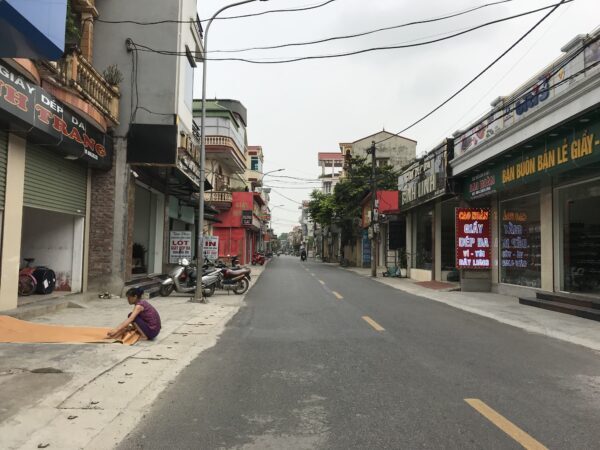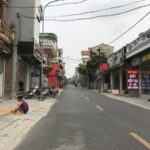Phu Yen Leather and Footwear Village is located on National Highway 1A, close to Gie Bridge, near Nhue River, Luong River and more than 40km from the center of Hanoi. Phu Yen footwear and leather products are present in most provinces and cities nationwide, from small and retail shops to fashion stores and supermarkets. Those who have used Phu Yen’s leather and footwear products affirm that the imitation leather or the genuine leather of Phu Yen is of good quality, durable but beautiful, fashionable and stylish. According to leaders of Phu Yen commune and Phu Yen Leather and Footwear Association, the whole commune has nearly 200 households, production and business groups, attracting more than 3,000 workers inside and outside the commune. Each year, Phu Yen produces about 5 million pairs of shoes and leather sandals, equivalent to the annual output of a factory. Total income from footwear and leather and footwear business accounts for 86% of the total income of the commune. The trade village’s products are mainly consumed in the northern provinces and Hanoi capital (80%), in the southern provinces, and exported to Laos and Cambodia.
Many businesses such as Nguyen Thanh Quang’s shoe production facility, Son Linh leather footwear factory, Luong Huy manufacturing facility of 1/1 class invalids Nguyen Luong Doan – who has the first credit in trade village development are successful. These products have won the Capital Gold Quality Award 2012. There are also production facilities such as Tuan Huyen, Cao Hoan, Hung Giang, Hang Xuyen, Diep Luyen…

Arriving in Phu Yen on a day of May from the beginning of Gie bridge leading into the commune, we could feel the atmosphere of the trade village here because of the smell of leather, the smell of glue and the crackling sound of leather cutters. From Gie Ha village to Gie Thuong and other villages, there are only high-rise buildings, shoe shops, large, spacious factories and production facilities like in town… On the big and wide village roads, there are trucks carrying goods everywhere, giving Phu Yen a bustling and hustle atmosphere.
Phu Yen is famous for its traditional leather and footwear products and has produced a giant leather shoe which has been recorded in the Guinness Vietnam. But Phu Yen is also famous because it produces talented and dynamic craftsmen. Because it is dynamic, when leather and footwear products in many countries, including Vietnam, fall into crisis and difficulties, Phu Yen still actively works at day and night to deliver goods to customers under contracts. The reason is that the craftsmen and the production establishments have quickly grasped the market, produced according to the tastes and pockets of consumers, from common leather and footwear products to high-quality leather and footwear products; from imitation leather products of VND 100 thousand to expensive leather products with the price of millions, several tens of millions dong and thousands of different designs, meeting the needs of all walks of life.
Good shoes should have good materials with a good core. Making shoes requires the craftsmen to have high technique and carefulness from cutting leather, sewing, forming, pressing soles, even decoration which must be careful and meticulous to have a beautiful and high-quality product. Mr. Le Van Hai, the author of the shoe winning the silver medal at the 2009 Asia-Pacific shoe fashion design competition, said a beautiful pair of shoes must be made of soft leather, right cuts, clean needle line and thread, and cause no foot pain. A craftsman who wants to be skilled must learn a few years to make a complete shoe.
Phu Yen currently has 2 people who are granted the title of folk artists, Mr. Le Van Thinh and Mr. Tran Huu Tieu. Particularly, the family of craftsmen Thinh has passed the craft for many generations who promote their ancestors’ traditions every time, produce unique products, honor the trade village and make many people aware of the Phu Yen traditional footwear brand.
The ancestor of Phu Yen craft village is Nguyen Mac. During the years of the French domination, from an owner of a shoe factory in Cau Dat street, Hai Phong city, Mr. Mac learned and switched to making shoes and transferring skills to his children. In the 60s and 70s of the last century, Phu Yen built a footwear cooperative, specializing in handling goods for the Export Leather Shoes Corporation. After this corporation was dissolved, the people of Phu Yen returned to their village to get rich in their own homeland. In 2001, the two villages Gie Ha and Gie Thuong in Phu Yen were recognized as the traditional footwear village. In 2013, Phu Yen was helped by the district to organize a ceremony to honor the trade village, which resonated throughout the country. At present, the commune has successfully built and registered the collective trademark of Phu Yen leather and footwear granted by the National Office of Intellectual Property and is applying advanced science and technology according to the 4.0 technology into the trade.
Yen is improving day by day, Phu Yen village is now a busy craft village, full of vitality. There are many millionaires and billionaires in the village. According to the report of Phu Yen Commune People’s Committee, the average income per capita of the commune is currently VND 52 million/person/year. Employees’ income is from VND 6-7 million/month. To preserve and promote the craft village in a long-term and sustainable direction, the People’s Committee of Phu Yen commune and the Phu Yen Leather and Footwear Association are proposing to Phu Xuyen district to plan a concentrated production area and invest in waste treatment. Currently, the commune is building the infrastructure of the small industry and handicraft cluster in Gie Ha village.
Quynh Anh

